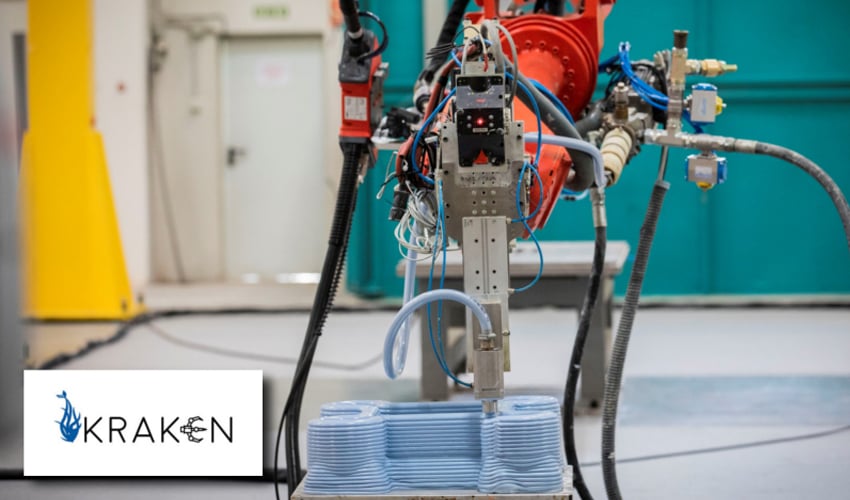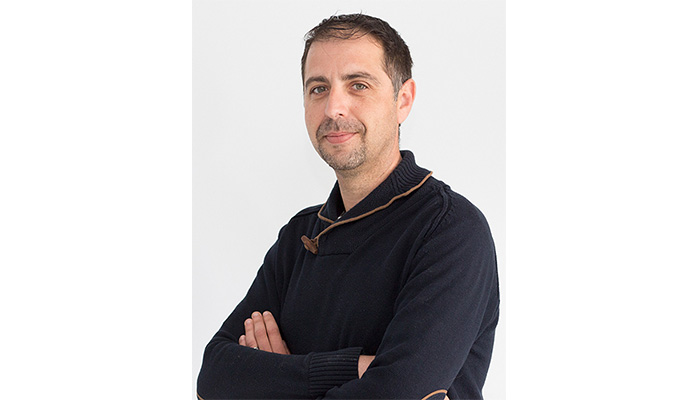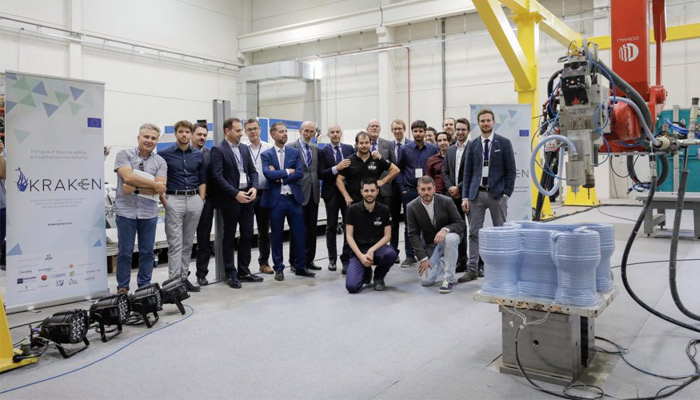KRAKEN, an all-in-one manufacturing machine to disrupt production

A few months ago we followed the development of the KRAKEN project, a system that combines both 3D printing technologies, robotics, and subtractive technologies. Thanks to its robotic arm, the system is able to 3D print surfaces of 20 square meters. Additionally, the variety of manufacturing materials KRAKEN can process make it 40% faster, 25% more productive and 30% cheaper according to the team behind the project. In order to learn more about the system, we interviewed José Antonio Dieste, researcher and coordinator behind the KRAKEN project, working for the AITIIP technology centre.
3DN: Could you introduce yourself and tell us about your relationship with 3D printing?
I’m José Antonio Dieste, head of robotics and mechatronics at AITIIP. At AITIIP we have been using 3D printing technologies since 2000, when we incorporated our first machine (an SLS machine), which is still in operation. At that time the term additive manufacturing or 3D printing did not yet exist and we called it rapid prototyping. That machine and technology was too advanced for its time. We were trying to exploit it as a technology service for companies, and although it was very visual for all our customers, they still didn’t see a direct application to their business. It was the big companies, especially in the automotive sector, who started hiring us to make aesthetic prototypes for their developments.

José Antonio Dieste
However, internally our engineering team made massive use of the machine as an internal resource, to validate new developments, new designs, and reduce the need for iterations in development, which made us more competitive by reducing project development times. Today, we have a large diversity of materials, technologies, in addition to all our lines of research, both in materials and in advanced processes and circular economy, which is anchored in 3D printing.
3DN: How did the KRAKEN Project come about?
At AITIIP we always try to find solutions to the problems of our clients and collaborators. Since 2012, we have been wondered if it would be possible to 3D print large pieces. KRAKEN tries to respond to the needs of big dimension products manufactured by means of additive technologies and in an efficient way. That is why KRAKEN has had to advance and develop new 3D printing technologies, which allow to print very big volumes in a fast way, and that is why we have bet on the development of new techniques with high contribution rates, both in polymers and in metals. Moreover, the combination with subtractive technologies such as milling, drilling, polishing, allows KRAKEN to take advantage of both philosophies (additive and subtractive), to develop an efficient methodology to be applied in an industrial way.

The team behind the KRAKEN project
3DN: What are the benefits of KRAKEN?
KRAKEN is a very wide development, both at 3D printing level, and robotics level – it includes control, metrology, real time error correction, offline software, and high level software. All these developments are customizable and we can think of turnkey systems for companies, which are adapted to their specific needs. At the moment we continue developing new features and we are considering the manufacture of large pieces, especially applied to moulds and tools, taking advantage of the possibilities of printing on various materials, as well as the manufacture of final parts for sectors such as aeronautics, construction and automotive. In short, although the KRAKEN pilot line is designed for large dimensions and with many functions, it be adapted to simpler systems that can be applied even in small companies.
3DN: In addition, you are working on the development of materials in your project called BARBARA. Could you explain more about it and tell us what it has to do with additive manufacturing?
The BARBARA project is directly related to additive manufacturing and aims to cover the entire value chain. New materials are being developed for FDM taking advantage of waste from the food industry, new functions are being added to them by integrating biomaterials into the bioplastic itself to improve properties such as mechanical and thermal resistance, new aesthetic finishes and colours, as an alternative to traditional thermoplastics.

BARBARA’s objective is to develop new biomaterials with innovative functionalities | Credits Aitiip
A great effort has been made to make these materials appropriate for 3D printing and traditional processes such as injection moulding, to which innovations have been added in the Additive Manufacturing processes to improve the consolidation of layers to obtain products that mechanically function optimally in all directions, and are not penalised by layer adhesion. Furthermore, BARBARA, as well as KRAKEN and all the projects coordinated by AITIIP, are oriented to the industry and aim to solve real cases. Therefore, in this final phase of the project, all the developments in processes and real products of the automotive and construction sector are being validated.
3DN: What future projects can we expect in relation to additive manufacturing?
Additive manufacturing is one of the standards of AITIIP, and we will continue betting on the development of additive manufacturing, from materials, processes, machines and products. KRAKEN, BARBARA and other projects of AITIIP have allowed to make great advances, new applications and new products, but also they have allowed to generate new ideas of the future, which will allow to advance these projects so that additive manufacture becomes more competitive and sustainable over time. The entire AITIIP team will continue working to remain a pioneer and reference in additive manufacturing in Aragon, Spain and Europe.
3DN: Do you have any last words for our readers?
I recommend readers to follow us on social networks, and on our website where they can see how projects and our ideas are evolving. We’ve established a line of communication with users, which allow us to understand their needs, their problems and listen to their ideas. In the end AITIIP never works alone and it is our customers and partners who help us focus on new developments. You can find more information HERE.
What do you think of this manufacturing system? Let us know in a comment below or on our Facebook and Twitter pages! Sign up for our free weekly Newsletter, all the latest news in 3D printing straight to your inbox!







